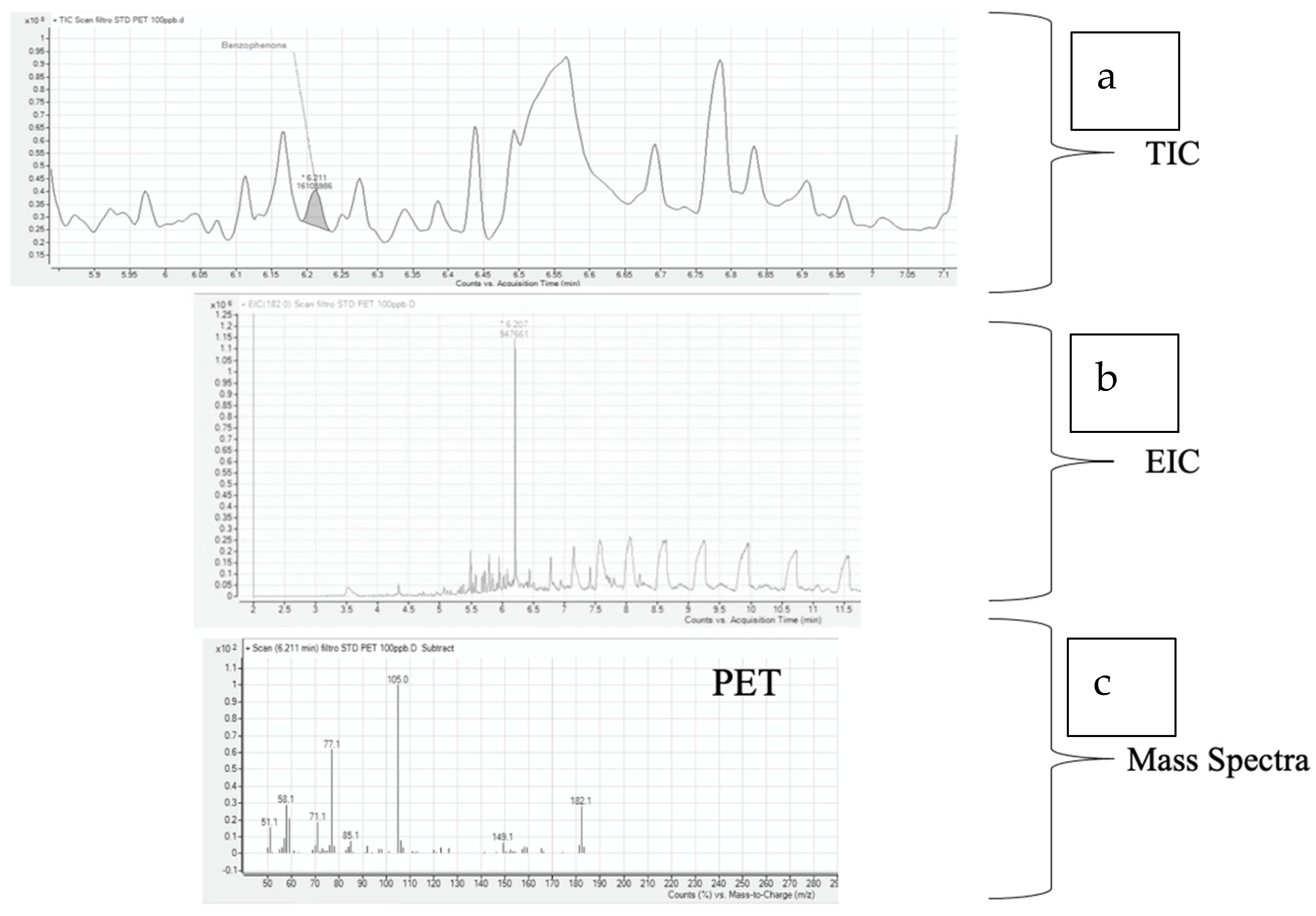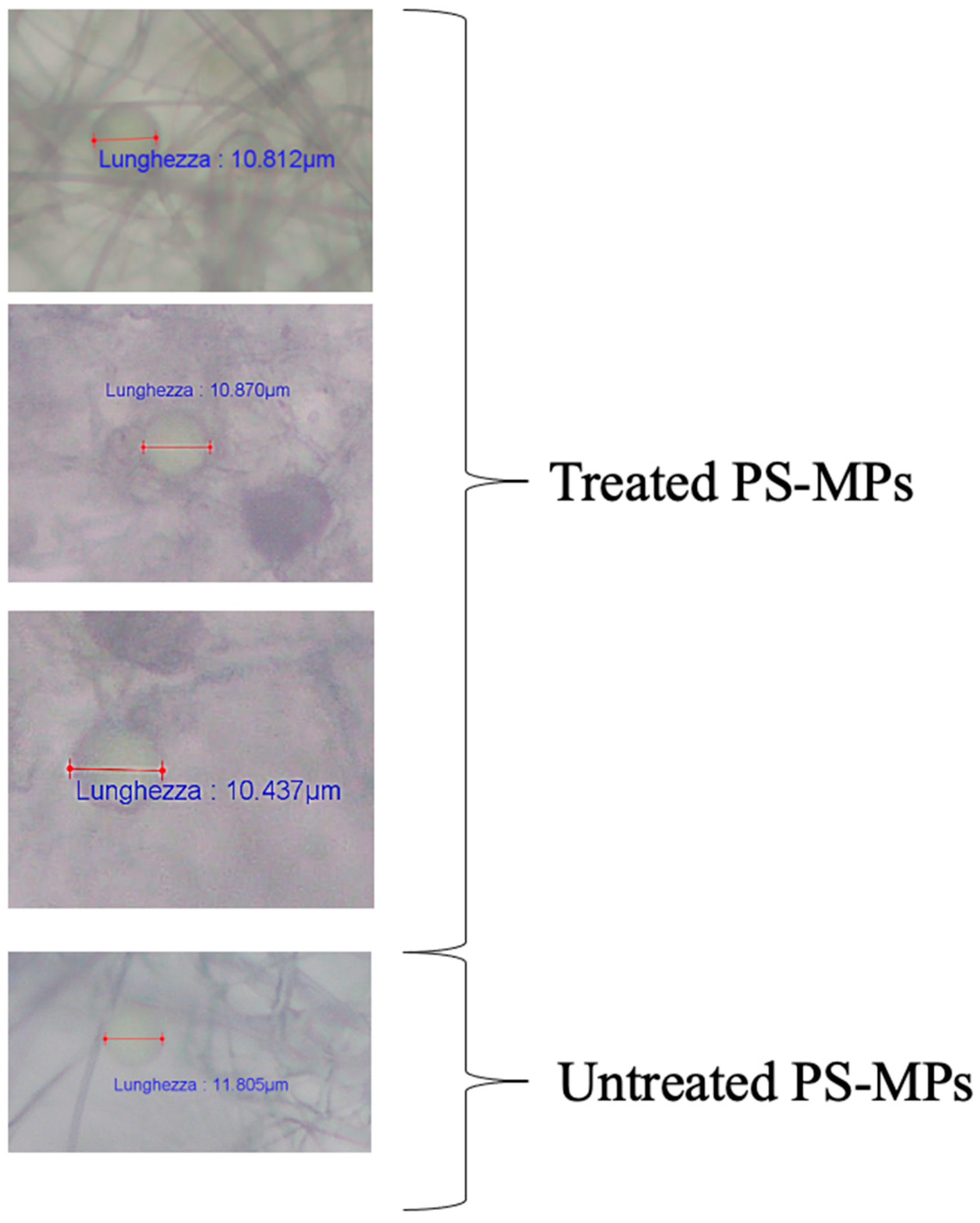First Approach for Defining an Analytical Protocol for the Determination of Microplastics in Cheese Using Pyrolysis–Gas Chromatography–Mass Spectrometry
Abstract
:1. Introduction
2. Materials and Methods
2.1. Samples Collection
2.2. Sample Digestion
2.3. Experimental Design
2.4. Microplastic Recovery Rate
2.5. Digestion Effects on Microplastics
2.6. Py–GC–MS Conditions and Analyses
2.7. Quality Control/Quality Assurance and Procedural Blanks
3. Results
3.1. Digestion Efficiency
3.2. Recovery Rate of Spiked PS-MPs
3.3. Effects of Digestion Agents on PS-MPs: Student’s t-Test
3.4. Qualification Using Py–GC–MS
4. Discussion
5. Conclusions
Author Contributions
Funding
Institutional Review Board Statement
Informed Consent Statement
Data Availability Statement
Acknowledgments
Conflicts of Interest
References
- Wang, H.-P.; Huang, X.-H.; Chen, J.-N.; Dong, M.; Zhang, Y.-Y.; Qin, L. Pouring Hot Water through Drip Bags Releases Thousands of Microplastics into Coffee. Food Chem. 2023, 415, 135717. [Google Scholar] [CrossRef]
- Muhib, M.I.; Uddin, M.K.; Rahman, M.M.; Malafaia, G. Occurrence of Microplastics in Tap and Bottled Water, and Food Packaging: A Narrative Review on Current Knowledge. Sci. Total Environ. 2023, 865, 161274. [Google Scholar] [CrossRef] [PubMed]
- Rbaibi Zipak, S.; Muratoglu, K.; Buyukunal, S.K. Microplastics in Raw Milk Samples from the Marmara Region in Turkey. J. Consum. Prot. Food Saf. 2024, 19, 175–186. [Google Scholar] [CrossRef]
- Kaseke, T.; Lujic, T.; Cirkovic Velickovic, T. Nano- and Microplastics Migration from Plastic Food Packaging into Dairy Products: Impact on Nutrient Digestion, Absorption, and Metabolism. Foods 2023, 12, 3043. [Google Scholar] [CrossRef]
- Kutralam-Muniasamy, G.; Pérez-Guevara, F.; Elizalde-Martínez, I.; Shruti, V.C. Branded Milks—Are They Immune from Microplastics Contamination? Sci. Total Environ. 2020, 714, 136823. [Google Scholar] [CrossRef] [PubMed]
- Lin, Q.; Zhao, S.; Pang, L.; Sun, C.; Chen, L.; Li, F. Potential Risk of Microplastics in Processed Foods: Preliminary Risk Assessment Concerning Polymer Types, Abundance, and Human Exposure of Microplastics. Ecotoxicol. Environ. Saf. 2022, 247, 114260. [Google Scholar] [CrossRef]
- Sridharan, S.; Kumar, M.; Singh, L.; Bolan, N.S.; Saha, M. Microplastics as an Emerging Source of Particulate Air Pollution: A Critical Review. J. Hazard. Mat. 2021, 418, 126245. [Google Scholar] [CrossRef]
- He, Y.-J.; Qin, Y.; Zhang, T.-L.; Zhu, Y.-Y.; Wang, Z.-J.; Zhou, Z.-S.; Xie, T.-Z.; Luo, X.-D. Migration of (Non-) Intentionally Added Substances and Microplastics from Microwavable Plastic Food Containers. J. Hazard. Mat. 2021, 417, 126074. [Google Scholar] [CrossRef]
- Fadare, O.O.; Wan, B.; Guo, L.-H.; Zhao, L. Microplastics from Consumer Plastic Food Containers: Are We Consuming It? Chemosphere 2020, 253, 126787. [Google Scholar] [CrossRef]
- Zhou, Y.; Liu, X.; Wang, J. Characterization of Microplastics and the Association of Heavy Metals with Microplastics in Suburban Soil of Central China. Sci. Total Environ. 2019, 694, 133798. [Google Scholar] [CrossRef]
- Di Fiore, C.; Carriera, F.; Russo, M.V.; Avino, P. Are Microplastics a Macro Issue? A Review on the Sources of Contamination, Analytical Challenges and Impact on Human Health of Microplastics in Food. Foods 2023, 12, 3915. [Google Scholar] [CrossRef] [PubMed]
- Basaran, B.; Özçifçi, Z.; Akcay, H.T.; Aytan, Ü. Microplastics in Branded Milk: Dietary Exposure and Risk Assessment. J. Food Compos. Anal. 2023, 123, 105611. [Google Scholar] [CrossRef]
- Da Costa Filho, P.A.; Andrey, D.; Eriksen, B.; Peixoto, R.P.; Carreres, B.M.; Ambühl, M.E.; Descarrega, J.B.; Dubascoux, S.; Zbinden, P.; Panchaud, A.; et al. Detection and Characterization of Small-Sized Microplastics (≥ 5 Μm) in Milk Products. Sci. Rep. 2021, 11, 24046. [Google Scholar] [CrossRef] [PubMed]
- Alak, G.; Köktürk, M.; Atamanalp, M. Evaluation of Different Packaging Methods and Storage Temperature on MPs Abundance and Fillet Quality of Rainbow Trout. J. Hazard. Mat. 2021, 420, 126573. [Google Scholar] [CrossRef]
- Akoueson, F.; Sheldon, L.M.; Danopoulos, E.; Morris, S.; Hotten, J.; Chapman, E.; Li, J.; Rotchell, J.M. A Preliminary Analysis of Microplastics in Edible versus Non-Edible Tissues from Seafood Samples. Environ. Pollut. 2020, 263, 114452. [Google Scholar] [CrossRef] [PubMed]
- Zhang, D.; Fraser, M.A.; Huang, W.; Ge, C.; Wang, Y.; Zhang, C.; Guo, P. Microplastic Pollution in Water, Sediment, and Specific Tissues of Crayfish (Procambarus clarkii) within Two Different Breeding Modes in Jianli, Hubei Province, China. Environ. Pollut. 2021, 272, 115939. [Google Scholar] [CrossRef] [PubMed]
- Van Cauwenberghe, L.; Claessens, M.; Vandegehuchte, M.B.; Janssen, C.R. Microplastics Are Taken up by Mussels (Mytilus edulis) and Lugworms (Arenicola marina) Living in Natural Habitats. Environ. Pollut. 2015, 199, 10–17. [Google Scholar] [CrossRef]
- Sembiring, E.; Fareza, A.A.; Suendo, V.; Reza, M. The Presence of Microplastics in Water, Sediment, and Milkfish (Chanos chanos) at the Downstream Area of Citarum River, Indonesia. Water Air Soil Pollut. 2020, 231, 355. [Google Scholar] [CrossRef]
- Prata, J.C.; Da Costa, J.P.; Duarte, A.C.; Rocha-Santos, T. Methods for Sampling and Detection of Microplastics in Water and Sediment: A Critical Review. Trends Anal. Chem. 2019, 110, 150–159. [Google Scholar] [CrossRef]
- Duman, S.; Doyen, P.; Merveillie, P.; Andersson, N.; Bayeuil, R.; Grard, T.; Dehaut, A.; Duflos, G. Optimization of a Method Designed to Extract and Characterize Microplastics in Different Packaged Fish Products. Food Control 2023, 154, 110029. [Google Scholar] [CrossRef]
- Löder, M.G.J.; Imhof, H.K.; Ladehoff, M.; Löschel, L.A.; Lorenz, C.; Mintenig, S.; Piehl, S.; Primpke, S.; Schrank, I.; Laforsch, C.; et al. Enzymatic Purification of Microplastics in Environmental Samples. Environ. Sci. Technol. 2017, 51, 14283–14292. [Google Scholar] [CrossRef] [PubMed]
- Di Fiore, C.; Ishikawa, Y.; Wright, S.L. A Review on Methods for Extracting and Quantifying Microplastic in Biological Tissues. J. Hazard. Mat. 2024, 464, 132991. [Google Scholar] [CrossRef] [PubMed]
- Tuttle, E.; Stubbins, A. An Optimized Acidic Digestion for the Isolation of Microplastics from Biota-Rich Samples and Cellulose Acetate Matrices. Environ. Pollut. 2023, 322, 121198. [Google Scholar] [CrossRef] [PubMed]
- Bianchi, J.; Valente, T.; Scacco, U.; Cimmaruta, R.; Sbrana, A.; Silvestri, C.; Matiddi, M. Food Preference Determines the Best Suitable Digestion Protocol for Analysing Microplastic Ingestion by Fish. Mar. Pollut. Bull. 2020, 154, 111050. [Google Scholar] [CrossRef] [PubMed]
- Fraissinet, S.; Pennetta, A.; Rossi, S.; De Benedetto, G.E.; Malitesta, C. Optimization of a New Multi-Reagent Procedure for Quantitative Mussel Digestion in Microplastic Analysis. Mar. Pollut. Bull. 2021, 173, 112931. [Google Scholar] [CrossRef] [PubMed]
- Lee, S.-Y.; An, J.; Kwon, J.-H. Sequential Quantification of Number and Mass of Microplastics in Municipal Wastewater Using Fourier-Transform Infrared Spectroscopy and Pyrolysis Gas Chromatography-Mass Spectrometry. Environ. Pollut. 2023, 336, 122452. [Google Scholar] [CrossRef]
- Lauschke, T.; Dierkes, G.; Ternes, T.A. Challenges in the Quantification of Poly(Ethylene Terephthalate) Microplastics via Thermoanalytical Methods Posed by Inorganic Matrix Components. J. Anal. Appl. Pyrolysis 2023, 174, 106108. [Google Scholar] [CrossRef]
- La Nasa, J.; Biale, G.; Fabbri, D.; Modugno, F. A Review on Challenges and Developments of Analytical Pyrolysis and Other Thermoanalytical Techniques for the Quali-Quantitative Determination of Microplastics. J. Anal. Appl. Pyrolysis 2020, 149, 104841. [Google Scholar] [CrossRef]
- Ishimura, T.; Iwai, I.; Matsui, K.; Mattonai, M.; Watanabe, A.; Robberson, W.; Cook, A.-M.; Allen, H.L.; Pipkin, W.; Teramae, N.; et al. Qualitative and Quantitative Analysis of Mixtures of Microplastics in the Presence of Calcium Carbonate by Pyrolysis-GC/MS. J. Anal. Appl. Pyrolysis 2021, 157, 105188. [Google Scholar] [CrossRef]
- Fabbri, D.; Rombolà, A.G.; Vassura, I.; Torri, C.; Franzellitti, S.; Capolupo, M.; Fabbri, E. Off-Line Analytical Pyrolysis GC–MS to Study the Accumulation of Polystyrene Microparticles in Exposed Mussels. J. Anal. Appl. Pyrolysis 2020, 149, 104836. [Google Scholar] [CrossRef]
- Munno, K.; Helm, P.A.; Jackson, D.A.; Rochman, C.; Sims, A. Impacts of Temperature and Selected Chemical Digestion Methods on Microplastic Particles. Environ. Toxicol. Chem. 2018, 37, 91–98. [Google Scholar] [CrossRef] [PubMed]
- Makhdoumi, P.; Pirsaheb, M.; Amin, A.A.; Kianpour, S.; Hossini, H. Microplastic Pollution in Table Salt and Sugar: Occurrence, Qualification and Quantification and Risk Assessment. J. Food Compos. Anal. 2023, 119, 105261. [Google Scholar] [CrossRef]
- Barboza, L.G.A.; Dick Vethaak, A.; Lavorante, B.R.B.O.; Lundebye, A.-K.; Guilhermino, L. Marine Microplastic Debris: An Emerging Issue for Food Security, Food Safety and Human Health. Mar. Pollut. Bull. 2018, 133, 336–348. [Google Scholar] [CrossRef] [PubMed]
- Smith, M.; Love, D.C.; Rochman, C.M.; Neff, R.A. Microplastics in Seafood and the Implications for Human Health. Curr. Environ. Health Rep. 2018, 5, 375–386. [Google Scholar] [CrossRef]
- Mattsson, K.; Johnson, E.V.; Malmendal, A.; Linse, S.; Hansson, L.-A.; Cedervall, T. Brain Damage and Behavioural Disorders in Fish Induced by Plastic Nanoparticles Delivered through the Food Chain. Sci. Rep. 2017, 7, 11452. [Google Scholar] [CrossRef]
- Monteiro, S.S.; Pinto Da Costa, J. Methods for the Extraction of Microplastics in Complex Solid, Water and Biota Samples. Trends Environ. Anal. Chem. 2022, 33, e00151. [Google Scholar] [CrossRef]
- Dehaut, A.; Cassone, A.-L.; Frère, L.; Hermabessiere, L.; Himber, C.; Rinnert, E.; Rivière, G.; Lambert, C.; Soudant, P.; Huvet, A.; et al. Microplastics in Seafood: Benchmark Protocol for Their Extraction and Characterization. Environ. Pollut. 2016, 215, 223–233. [Google Scholar] [CrossRef]
- Junhao, C.; Xining, Z.; Xiaodong, G.; Li, Z.; Qi, H.; Siddique, K.H.M. Extraction and Identification Methods of Microplastics and Nanoplastics in Agricultural Soil: A Review. J. Environ. Manag. 2021, 294, 112997. [Google Scholar] [CrossRef]
- Thiele, C.J.; Hudson, M.D.; Russell, A.E. Evaluation of Existing Methods to Extract Microplastics from Bivalve Tissue: Adapted KOH Digestion Protocol Improves Filtration at Single-Digit Pore Size. Mar. Pollut. Bull. 2019, 142, 384–393. [Google Scholar] [CrossRef]
- Park, H.; Park, B. Review of Microplastic Distribution, Toxicity, Analysis Methods, and Removal Technologies. Water 2021, 13, 2736. [Google Scholar] [CrossRef]




| Digestion Reagent | Temperature/Time | Concentration | Digestion Efficiency |
|---|---|---|---|
| KOH | 50 °C for 48 h | 5 M | 97.5 ± 0.8% |
| KOH | RT for 48 h | 5 M | 96.7 ± 2.6% |
| KOH | 50 °C for 48 h | 1 M | 91.6 ± 1.5% |
| KOH | RT for 48 h | 1 M | 89.7 ± 2.1% |
| Fenton’s Reagent | <50 °C for 20–30 min | - | 87.3 ± 3.4% |
| HNO3 | RT for 72 h | 65% | 82.3 ± 1.2% |
| H2O2 | 50° C for 48 h | 30% | 67.3 ± 5.3% |
| H2O2 | RT for 48 h | 30% | 64.1 ± 3.8% |
| Untreated PS-MPs | KOH 5 M 50 °C 24 h | KOH 5 M RT 24 h | |
|---|---|---|---|
| Mean | 11.9 ± 1.1 µm | 11.1 ± 0.7 µm | 11.3 ± 0.2 µm |
| Observations | 116 | 116 | 116 |
| Stat t | 5.5 | 4.7 | |
| Two-tailed P | 2.30 × 10−7 | 4.22 × 10−6 | |
| Critical two-tailed t | 1.98 | 1.97 |
Disclaimer/Publisher’s Note: The statements, opinions and data contained in all publications are solely those of the individual author(s) and contributor(s) and not of MDPI and/or the editor(s). MDPI and/or the editor(s) disclaim responsibility for any injury to people or property resulting from any ideas, methods, instructions or products referred to in the content. |
© 2024 by the authors. Licensee MDPI, Basel, Switzerland. This article is an open access article distributed under the terms and conditions of the Creative Commons Attribution (CC BY) license (https://creativecommons.org/licenses/by/4.0/).
Share and Cite
Di Fiore, C.; Carriera, F.; Iannone, A.; Paris, E.; Gallucci, F.; Avino, P. First Approach for Defining an Analytical Protocol for the Determination of Microplastics in Cheese Using Pyrolysis–Gas Chromatography–Mass Spectrometry. Appl. Sci. 2024, 14, 5621. https://doi.org/10.3390/app14135621
Di Fiore C, Carriera F, Iannone A, Paris E, Gallucci F, Avino P. First Approach for Defining an Analytical Protocol for the Determination of Microplastics in Cheese Using Pyrolysis–Gas Chromatography–Mass Spectrometry. Applied Sciences. 2024; 14(13):5621. https://doi.org/10.3390/app14135621
Chicago/Turabian StyleDi Fiore, Cristina, Fabiana Carriera, Alessia Iannone, Enrico Paris, Francesco Gallucci, and Pasquale Avino. 2024. "First Approach for Defining an Analytical Protocol for the Determination of Microplastics in Cheese Using Pyrolysis–Gas Chromatography–Mass Spectrometry" Applied Sciences 14, no. 13: 5621. https://doi.org/10.3390/app14135621





